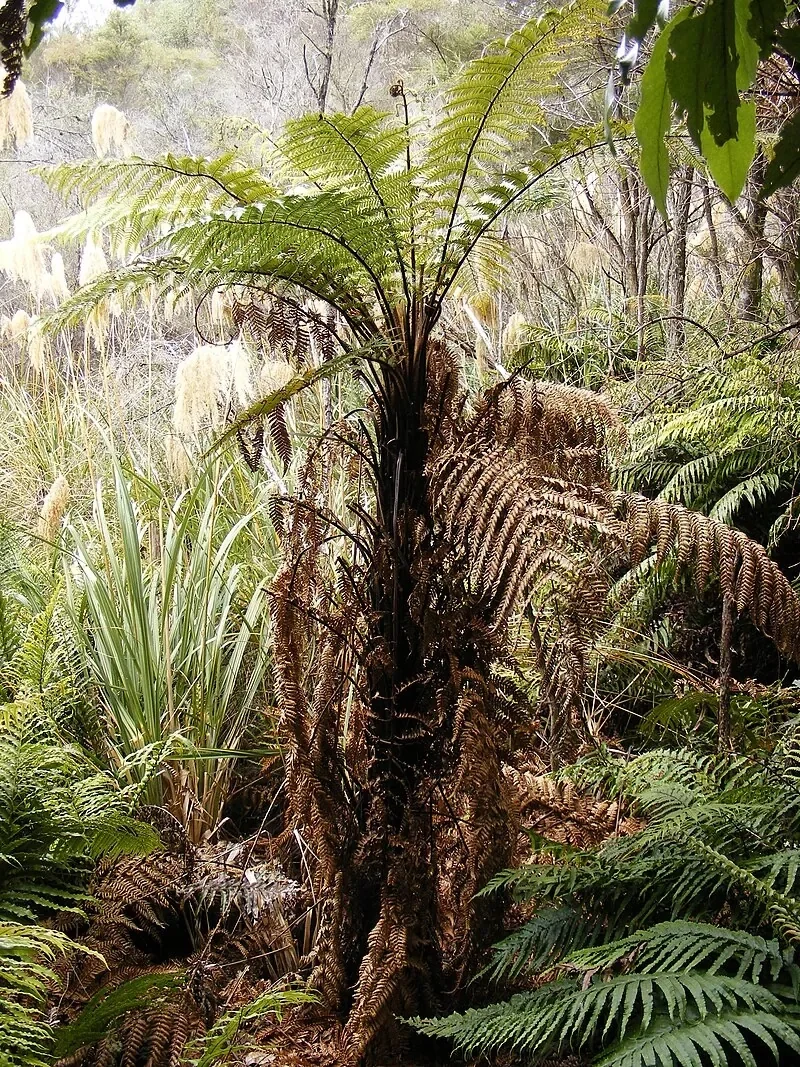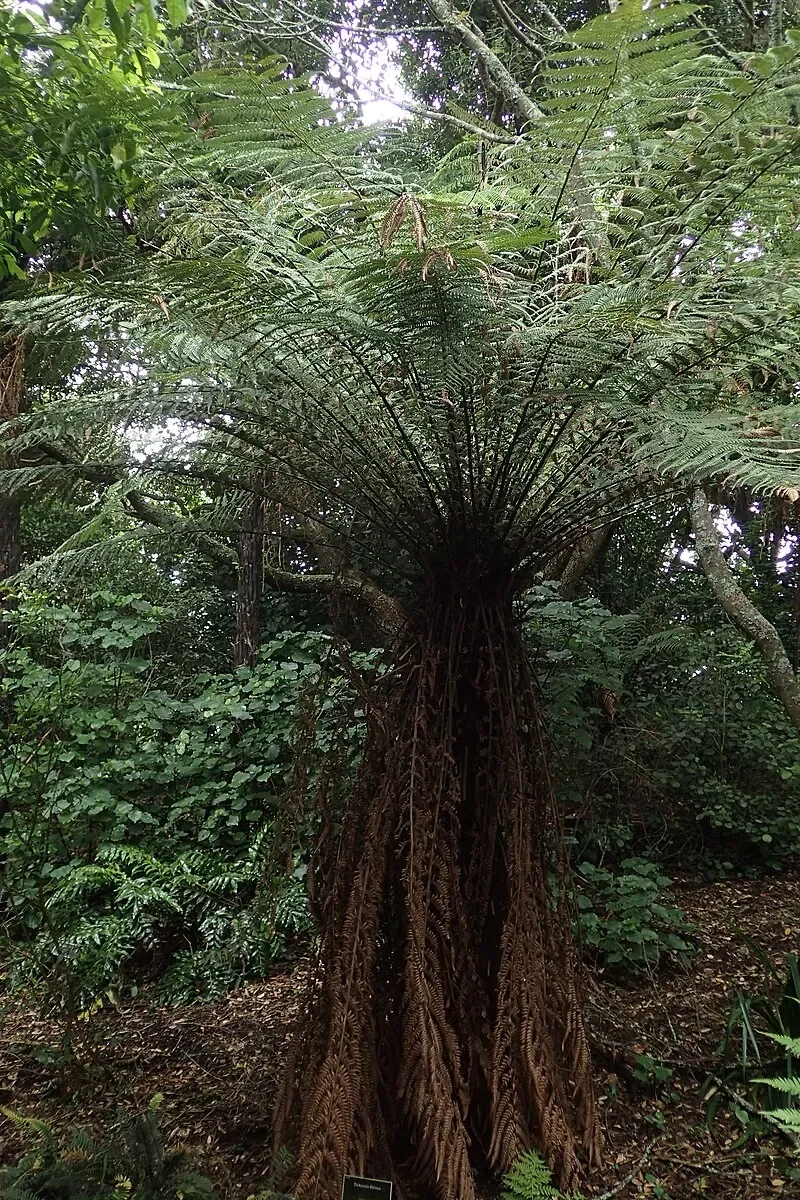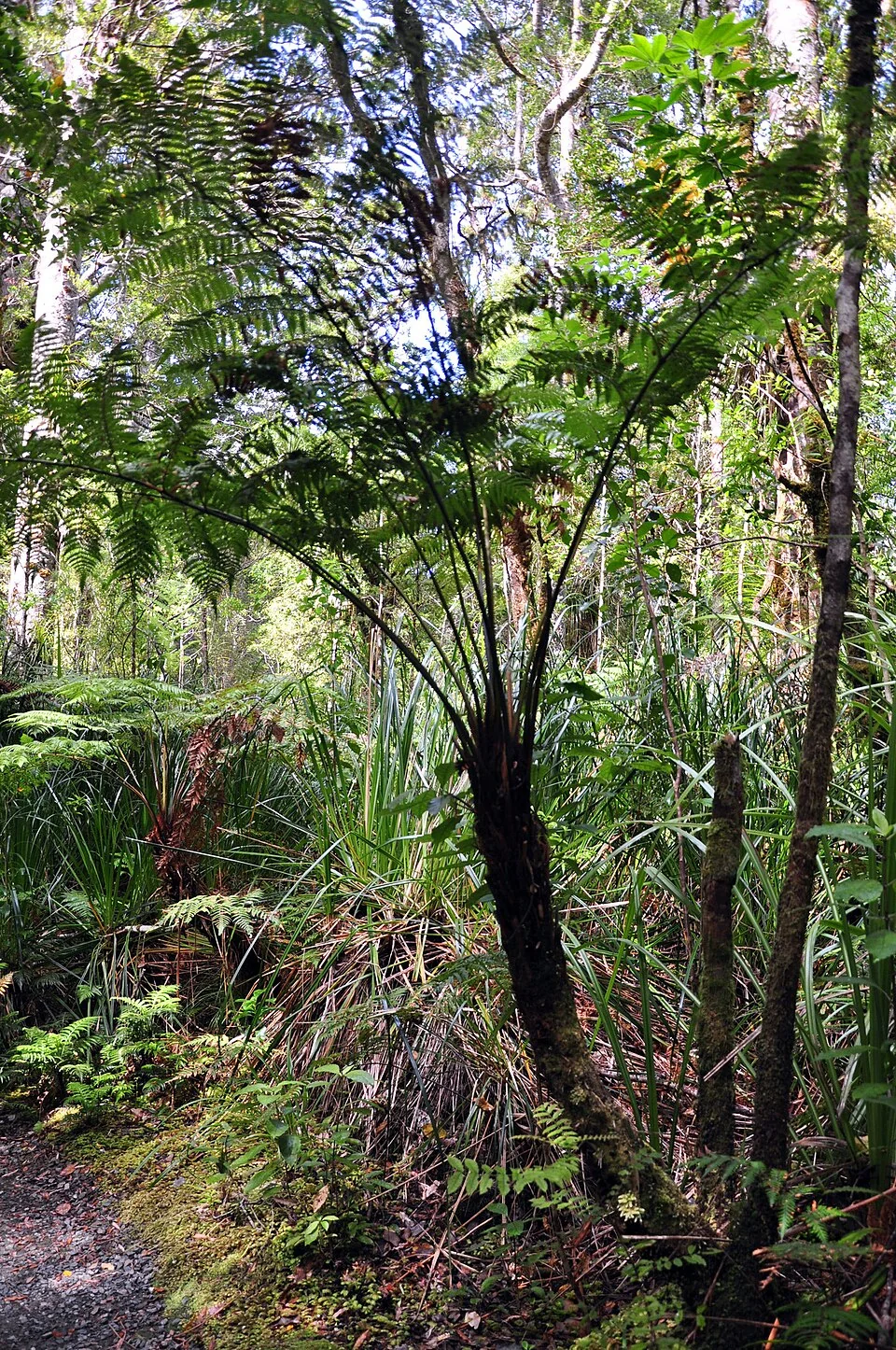
Whēkī
Dicksonia squarrosa
Introduction
Introduction Overview
Whēkī, scientifically known as Dicksonia squarrosa , is a magnificent native tree fern that forms one of the most distinctive and culturally significant components of New Zealand's forest understory, reaching heights of 6-8 meters with a characteristic fibrous trunk topped by an elegant crown of large, twice-pinnate fronds measuring 1-3 meters long. This slow -growing tree fern is distinguished from its larger cousin, the mamaku, by its rough, brown fibrous trunk surface formed from aerial rootlets, and its relatively smaller stature and narrower fronds that create a more delicate, lacy appearance as they unfurl from distinctive golden-brown croziers. Endemic to New Zealand and found throughout both main islands in lowland to montane forests, particularly in moist gullies and stream-sides, whēkī holds deep cultural significance for Māori, who traditionally used its starchy pith (core) as a famine food and its fibrous trunk material for building and craft purposes. In cultivation , this majestic tree fern thrives in sheltered, humid conditions with consistent moisture and partial shade, making it an outstanding choice for creating authentic New Zealand forest gardens, shaded courtyards, and subtropical plantings where its architectural form and graceful fronds provide year-round structure and a sense of ancient, primeval beauty that connects gardens to New Zealand's unique botanical heritage. ferns .

Plant Description
Botanical Features
Dicksonia squarrosa , commonly known as Whēkā or Rough Tree Fern, is a magnificent native tree fern endemic to New Zealand. It can grow up to 7 meters tall, with a slender, black trunk typically 15-25 centimeters in diameter. The trunk is composed of densely packed aerial roots and old frond bases, giving it a rough, fibrous texture. It often has persistent dead frond bases clinging to the trunk, creating a "skirt" effect. The plant has a crown of dark green, arching fronds that can be 1-3 meters long, which are bipinnate, deeply lobed, and finely divided, giving them a feathery appearance. Whēkā exhibits a unique suckering growth habit, forming dense groves through spreading underground rhizomes. It thrives in cool, moist, sheltered environments and is found throughout New Zealand's North Island and in the northern and western parts of the South Island, particularly in lowland to montane forests, moist gullies, and stream-sides.
Quick Facts
| Scientific Name | Dicksonia Squarrosa |
|---|---|
| Height | 4-6 m (occasionally up to 10 m) |
| Spread | 2-3 m |
| Water Needs | Moderate to high; keep soil consistently moist |
| Light | Dappled to deep shade |
| Frost Tolerance | Moderate; tolerates light frosts when established |
| Salt Tolerance | Low; does not tolerate salt spray |
| Growth Rate | Moderate to fast |
| Lifespan | Long-lived (decades) |
Whēkā is native to the forests of New Zealand, where it thrives in cool, moist, sheltered environments. It is found throughout the North Island and in the northern and western parts of the South Island. It prefers areas with consistent moisture, protection from strong winds, and moderate temperatures.
Regional Suitability
| City | Suitability |
|---|---|
| Whangārei | Ideal |
| Auckland | Ideal |
| Hamilton | Ideal |
| Tauranga | Ideal |
| Rotorua | Ideal |
| Gisborne | Ideal |
| New Plymouth | Ideal |
| Napier | Ideal |
| Whanganui | Ideal |
| Palmerston North | Ideal |
| Wellington | Ideal |
| Nelson | Ideal |
| Christchurch | Ideal |
| Dunedin | Ideal |
| Invercargill | Ideal |
Natural Habitat
Natural Habitat Overview
Dicksonia is naturally found in specific habitats throughout New Zealand. Understanding its natural environment helps in providing appropriate growing conditions in cultivation.
Plant Conservation
Dicksonia squarrosa , also known as the New Zealand tree fern or whēkī, is currently classified as "Not Threatened" in New Zealand. This status was most recently assessed in 2023, and it has consistently been listed as "Not Threatened" in previous assessments dating back to 2004. Regionally, it is also considered "Regionally Not Threatened" in areas like Auckland (2025) and Otago (2024).
This species is endemic to New Zealand, found across the North Island, South Island, Stewart Island/Rakiura, and Chatham Islands. It is a common tree fern that can form extensive groves due to its spreading underground rhizomes. It is also easily cultivated and commonly available from nurseries.
Soil Requirements
Whēkā performs best in the following soil conditions:
- Rich, humus-filled soil
- Good moisture retention
- Well-draining but consistently damp
- Slightly acidic to neutral pH (5.5-7.0)
- Benefits from added leaf mold or composted pine needles
- Tolerates poor soils if moisture is adequate
Light Requirements
This tree fern prefers shaded conditions:
- Dappled to deep shade
- Protection from direct sunlight, especially midday sun
- Morning sun tolerated in cooler regions
- Ideal under canopy of taller trees
- Can tolerate more light if soil remains consistently moist
- Young plants need more shade than established specimens
Water Requirements
Whēkā has moderate to high water needs:
- Regular watering , especially during establishment
- Keep soil consistently moist but not waterlogged
- Water both the crown and soil during dry periods
- Mulch to retain soil moisture
- Reduce watering slightly in winter
- Increased watering needed during hot, dry periods
Temperature Tolerance
Whēkā has the following temperature preferences:
- Prefers moderate temperatures
- Ideal growing range: 10-25°C (50-77°F)
- Can tolerate light frosts once established
- Protect from severe frost in colder regions
- Avoid hot , dry conditions
- Provide extra humidity during hot periods
Wind Tolerance
Whēkā has moderate wind tolerance:
- Prefers sheltered locations
- Protection from strong, drying winds
- Fronds can be damaged by persistent wind
- Plant in groups for mutual protection
- Use windbreaks in exposed gardens
- More wind -tolerant than many other tree ferns
Growth Habit
Understanding Whēkā's growth habit:
- Slender, black trunk up to 7 meters tall
- Distinctive suckering habit, forming groves
- Crown of dark green, arching fronds
- Slow trunk growth (5-10 cm per year)
- Moderate frond production
- Persistent dead frond bases on trunk
Planting Guide
Whēkā ( Dicksonia squarrosa ) prefers moist, shaded environments and thrives in rich, well-draining soil. When planting , ensure the trunk base is just above soil level. Water regularly , especially during dry periods, and mulch to retain moisture. Avoid direct sun and strong winds, which can damage fronds. Whēkā is ideal for forest gardens and shaded borders.
Ecological Role
Wildlife Interactions
Dicksonia plays an important ecological role in New Zealand's native ecosystems. It provides habitat and food for native wildlife and contributes to ecosystem health and biodiversity.
Garden Uses
- Dicksonia squarrosa serves as a dramatic feature plant in shaded gardens, providing architectural interest and a sense of ancient forest.
- It is ideal for understory planting in native forest gardens, contributing to a lush, multi-layered ecosystem.
- Its suckering habit and resilience make it valuable for restoration and revegetation projects, helping to establish new forest areas.
Landscaping Uses
Landscaping Uses Overview
Dicksonia is highly valued in landscaping for its aesthetic appeal and practical benefits. It can be used in various garden styles and landscape applications.
Spring
- New fronds emerge
- Mulch and water regularly
Summer
- Monitor for pests
- Water during dry spells
Autumn
- Remove dead fronds
- Divide suckers if desired
Winter
- Protect young plants from frost
- Minimal care required
Pruning and Maintenance
Pruning and Maintenance Overview
Whēkā ( Dicksonia squarrosa ) requires little pruning. Remove dead or damaged fronds at the base to maintain a tidy appearance and encourage healthy new growth. Avoid cutting into the trunk, as this can damage the plant. Pruning is best done in late winter or early spring before new fronds emerge.
How to Grow Whēkī
Whēkī, also known as the Rough Tree Fern, is a distinctive and robust native tree fern that can add a touch of ancient New Zealand forest to any shaded garden. Its slender, black trunk, often covered in persistent stipe bases, and crown of elegant fronds make it a popular choice for woodland settings, ferneries, and sheltered courtyards. While it is a relatively hardy tree fern, successful cultivation requires attention to its specific needs, particularly regarding consistent moisture, shade, and protection from strong winds. Understanding its propagation methods can help in expanding its presence and ensuring its continued success.
From Spores
Propagating Whēkī from spores is the primary method for reproduction in nature and can be a rewarding endeavor for patient gardeners. Collect mature spores from the undersides of healthy fronds when they are dark brown and easily dislodge. Sow the spores onto a sterile, moist substrate, such as peat or a specialized fern-growing medium, in a sealed container to maintain high humidity. Keep the container in a warm, dimly lit location. Germination can take several weeks to many months, forming a green, moss-like prothallus. Eventually, tiny fern sporophytes will emerge. Once they are large enough to handle, transplant them into individual pots and gradually acclimate them to lower humidity before planting out.
From Suckers
Whēkī often produces suckers from the base of its trunk, especially in established plants. These suckers can be carefully separated from the parent plant and grown into new specimens. This is best done in autumn or early spring. Ensure each sucker has a good root system attached. Plant the suckers into a well-draining, humus-rich potting mix and keep them in a sheltered, moist environment until they are well-established. This method is generally more reliable and faster than spore propagation for home gardeners.
From Trunk Sections
For established Whēkī, propagation from trunk sections is a surprisingly effective method, particularly for salvaging damaged plants or for creating new specimens from mature trunks. This method involves cutting a section of the trunk (at least 30-50 cm long) from a healthy plant. Ensure the top end is clearly marked. Plant the trunk section upright in a well-draining, humus-rich soil mix, burying about one-third of its length. Keep the trunk consistently moist, especially the top, and provide shade. New fronds will eventually emerge from the top of the trunk. This method is often used for larger specimens and can provide a quicker route to a mature-looking plant than spore propagation.
Pests and Diseases
Common Pests
Dicksonia is generally resistant to most pests due to its native adaptations. However, it may occasionally be affected by common garden pests such as aphids or scale insects.
Disease Prevention
To prevent diseases, ensure good air circulation around Dicksonia and avoid overwatering. Remove any diseased plant material promptly to prevent spread.
Cultural Significance
Dicksonia squarrosa , commonly known as whēkī or the rough tree fern, holds significant cultural importance, particularly for the Māori people of New Zealand.
Traditional Uses:
- Construction Material: The fibrous trunks of Dicksonia squarrosa were highly valued by Māori for construction. Slabs cut from the thick stem were used as structural posts for buildings, food stores, and fences around fortified villages known as pā.
- Food Source: The starchy pith from the core of the whēkī was consumed as a famine food.
Contemporary Significance:
- In contemporary times, the trunks of whēkī continue to be used for landscaping, such as in retaining walls and garden edging.
- Beyond its utility, Dicksonia squarrosa is valued for its distinctive and robust appearance, contributing an ancient, prehistoric aesthetic to gardens and forming a crucial part of New Zealand's forest understory.
- While the silver fern (Cyathea dealbata) is widely recognized as a national symbol of New Zealand, whēkī also embodies deep cultural significance through its historical uses and enduring presence in the landscape. Some even suggest its resilience could make it a strong candidate for a national symbol.
Bonus Tip
A Living Fence
The fibrous trunks of Whēkī were traditionally used by Māori to construct palisades and fences. The trunks were stacked horizontally and would often sprout new growth, creating a living, regenerating wall. This is a testament to the resilience of this remarkable tree fern and its ability to regenerate from its trunk.







